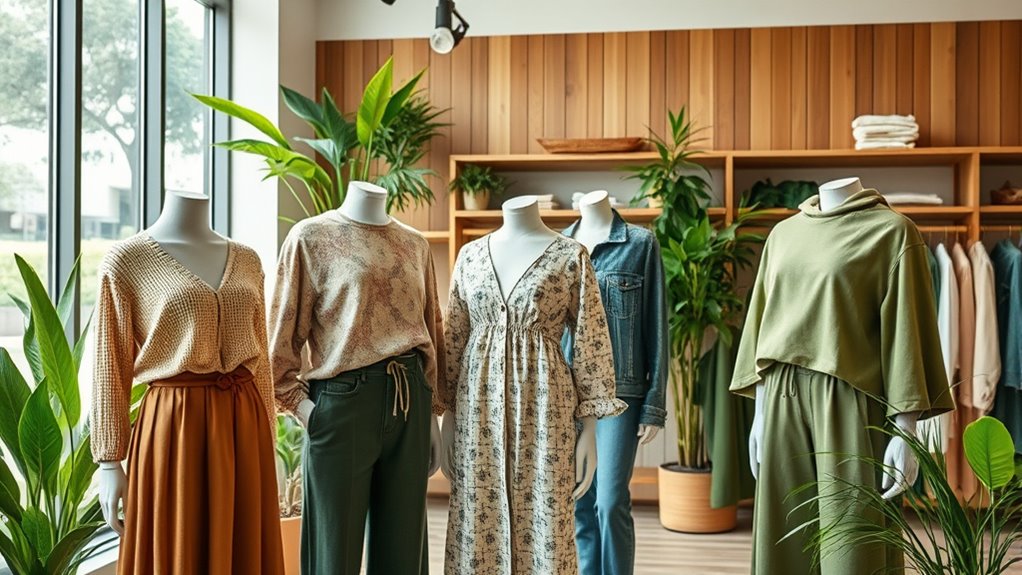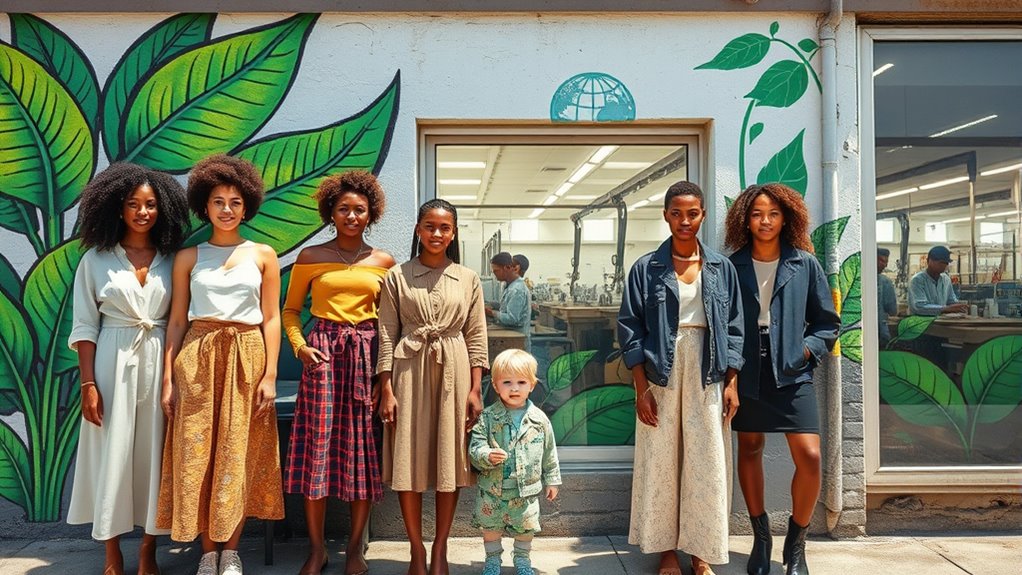You’re witnessing a major cultural shift where consumers like you prioritize sustainability and ethics in fashion. This change pushes brands to adopt eco-friendly materials, ethical production, and transparent practices. From choosing recycled fabrics to supporting fair labor, you can help promote a more responsible industry. As this movement grows, new innovations and trends emerge, shaping the future of eco-conscious style. Keep exploring to discover how you can make a difference in sustainable fashion.
Key Takeaways
- Consumers increasingly favor brands committed to transparency, ethical sourcing, and sustainable materials, driving a cultural shift toward eco-friendly fashion.
- The adoption of eco-friendly fabrics like organic cotton and recycled fibers reflects a growing demand for sustainable materials in apparel.
- Industry leaders promote responsible practices such as biodegradable packaging and fair wages, influencing consumer perceptions of stylish, conscious fashion.
- Cultural trends emphasize durability, versatility, and upcycling, encouraging a shift from fast fashion to long-lasting, eco-conscious wardrobe choices.
- Technological innovations like smart textiles and circular design models reinforce sustainable practices and reshape aesthetic standards.
The Evolution of Consumer Attitudes Toward Fashion

Over the years, consumer attitudes toward fashion have shifted considerably, driven by growing awareness of environmental and ethical issues. You’ve become more conscious of how fast fashion contributes to waste, pollution, and unfair labor practices, fueling a fast fashion backlash. This shift pushes you to seek out brands that prioritize sustainability and transparency. At the same time, luxury eco branding has gained popularity, as you want to support high-end labels committed to eco-friendly practices. You’re looking beyond just style to values like durability, ethical sourcing, and reduced environmental impact. This evolving mindset reflects a broader desire to make mindful choices, encouraging the industry to innovate and adopt sustainable practices. Recognizing the importance of Forsale 100, many consumers are now considering secondhand and vintage shopping as a way to reduce waste. Your changing preferences are shaping a more responsible and eco-conscious fashion landscape, and embracing creative practice can inspire innovative ways to support sustainable fashion initiatives. Additionally, the integration of sustainable materials into mainstream fashion designs underscores a commitment to reducing ecological footprints and promoting circular economy principles.
Key Sustainable Materials Transforming the Industry

You can see how innovations like organic cotton are making a difference, offering a sustainable alternative to traditional fabrics. Recycled fibers are transforming waste into new materials, reducing environmental impact. Plant-based dyes further cut down on chemical use, helping you make more eco-friendly fashion choices. Additionally, choosing fabrics with appropriate tire pressure can enhance comfort and durability, aligning with sustainable practices.
Organic Cotton Innovations
Organic cotton innovations are revolutionizing sustainable fashion by offering a greener alternative to conventional textiles. Through organic cotton farming, farmers use fewer chemicals and pesticides, reducing environmental impact and promoting healthier ecosystems. This method not only supports soil health but also guarantees that the cotton you wear is free from harmful residues. As brands adopt biodegradable packaging for their products, they enhance the eco-friendly lifecycle of organic cotton garments, minimizing waste and pollution. These innovations make it easier for you to choose clothing that aligns with your values, without sacrificing style or quality. By supporting organic cotton farming and sustainable packaging practices, you contribute to a more responsible fashion industry that prioritizes environmental health and future generations. Supporting sustainable practices further encourages industry-wide adoption of eco-friendly materials and methods. Additionally, the increasing demand for eco-conscious apparel has encouraged brands to invest in sustainable supply chains, fostering long-term environmental benefits. Incorporating environmentally friendly manufacturing techniques can further reduce pollution and resource consumption in the industry.
Recycled Fiber Usage
Building on the shift towards eco-friendly materials like organic cotton, recycled fibers are now transforming the fashion landscape by turning waste into valuable resources. The benefits of recycled fibers include reducing landfill waste, conserving water, and lowering carbon emissions. Fiber recycling processes typically involve collecting post-consumer textiles or industrial waste, then breaking them down and reforming them into new yarns. This approach not only minimizes environmental impact but also supports circular fashion models. Here’s a quick overview:
| Recycled Fiber Benefits | Fiber Recycling Processes |
|---|---|
| Reduces waste | Mechanical recycling (fiber shredding) |
| Saves water | Chemical recycling (breaking down fibers) |
| Lowers carbon footprint | Re-spinning into new textiles |
| Promotes sustainability | Sorting and cleaning waste materials |
Additionally, understanding the importance of spiritual energy can inspire more mindful consumption and support sustainable practices. Recognizing mindful consumption encourages consumers and brands to make choices that align with environmental and spiritual well-being.
A focus on circular fashion models further enhances the potential for sustainable growth within the industry, emphasizing reuse and recycling over waste.
Plant-Based Dyes
Have you ever wondered how fashion can be both vibrant and eco-friendly? Plant-based dyes are revolutionizing the industry through natural pigmentation and botanical coloring. These dyes come from plants, fruits, and vegetables, offering a sustainable alternative to synthetic dyes that often harm the environment. By harnessing botanical coloring, designers can create rich, lasting hues without polluting waterways or consuming excessive energy. This eco-conscious approach not only reduces chemical runoff but also supports biodiversity by encouraging the cultivation of dye plants. As you explore sustainable fashion, you’ll notice more brands adopting plant-based dyes to craft garments that are both colorful and eco-friendly. Embracing natural pigmentation helps you wear your values, making a positive impact on the planet with every vibrant, sustainable piece.
Ethical Manufacturing and Fair Labor Practices

Why should ethical manufacturing and fair labor practices matter in fashion? Because your choices impact workers’ lives and the environment. When brands prioritize supply chain transparency, you can see where your clothes come from and how they’re made. Worker empowerment ensures fair wages, safe conditions, and respect. By supporting brands committed to these principles, you promote a fairer industry. Here’s a quick look at key aspects:
| Aspect | What It Means | Why It Matters |
|---|---|---|
| Supply Chain Transparency | Clear visibility of production process | Builds trust and accountability |
| Fair Wages | Paying workers justly | Supports sustainable communities |
| Safe Working Conditions | Ensuring health and safety standards | Protects workers’ well-being |
| Worker Empowerment | Giving workers a voice and rights | Fosters dignity and fairness |
Supporting transparent and ethical practices in supply chain transparency can also lead to better product quality and durability, which benefits consumers and the planet alike. Additionally, embracing ethical manufacturing encourages innovation in sustainable materials and practices that further reduce environmental impact. Your choices drive change towards fair, ethical fashion.
Brands Leading the Eco-Friendly Movement

Several brands are now leading the eco-friendly movement in fashion by prioritizing sustainable materials, ethical practices, and transparency. Luxury labels like Stella McCartney and Gucci are setting new standards with eco-conscious collections and transparent supply chains. They use organic fabrics, recycled materials, and innovative techniques to reduce environmental impact. On the streetwear front, brands like Patagonia and Everlane emphasize durability, ethical sourcing, and eco-friendly production processes. These companies appeal to consumers who want style without sacrificing sustainability. By combining high-end craftsmanship with eco-conscious values, these brands prove that luxury and sustainability can go hand in hand. Their leadership encourages others in the industry to adopt greener practices, making sustainable fashion more accessible and desirable across different markets and styles. Additionally, the integration of sustainable materials in their collections highlights a growing commitment to eco-friendly fashion choices that benefit the environment. Moreover, their focus on ethical labor practices demonstrates a broader dedication to social responsibility within the industry. Furthermore, the emphasis on transparency in supply chains fosters consumer trust and accountability within the industry.
How Consumers Can Make More Conscious Choices

Consumers play a pivotal role in advancing sustainable fashion by making mindful choices that support eco-friendly brands and practices. Your decisions can drive meaningful change, from attending upcycling workshops to choosing brands that prioritize eco friendly packaging. When you opt for upcycled clothing, you help reduce waste and give new life to materials. Supporting brands that use eco friendly packaging minimizes plastic waste and promotes sustainable practices. Your conscious choices can inspire others and create demand for more ethical options. Additionally, incorporating skincare patches into your routine highlights the importance of mindful, small-scale changes that contribute to a more sustainable lifestyle. Being aware of sustainable packaging options can further enhance your positive impact. Recognizing the significance of eco-conscious materials can lead to more informed purchasing decisions that support environmental sustainability.
The Future of Fashion: Trends and Innovations

You’ll see exciting changes ahead with smart textile technologies that adapt to your needs and reduce waste. Circular economy initiatives are reshaping how brands design, reuse, and recycle materials to minimize environmental impact. These innovations are transforming fashion into a more sustainable and forward-thinking industry. Additionally, increased awareness of relationship dynamics encourages brands to foster ethical practices and transparent communication with consumers. As AI security concerns evolve, the industry is also focusing on integrating trustworthiness and safety measures into innovative fashion technologies to build consumer confidence. Moreover, adopting comprehensive retirement planning strategies can empower brands to allocate resources effectively toward sustainable innovations, ensuring long-term industry resilience.
Smart Textile Technologies
Have you ever wondered how technology is transforming the future of fashion? Smart textile technologies are revolutionizing how you experience clothing. With smart fabric and wearable technology, garments can adapt to your needs, offering comfort, functionality, and style simultaneously. Imagine clothing that adjusts to temperature, monitors your health, or even charges your devices. You’ll feel empowered knowing that: – Your outfit can respond dynamically to your environment – Clothing can track your essential signs for better health management – Wearable tech seamlessly blends fashion with practicality – Sustainable innovations reduce waste and extend garment lifespan These advancements make fashion more personalized, eco-friendly, and innovative. By integrating smart fabrics into everyday wear, you’ll step into a future where clothing isn’t just a statement but an extension of your lifestyle. Additionally, incorporating organic farming methods into textile production can further enhance sustainability and reduce environmental impact. Understanding the cultural shift towards eco-friendly style can inspire consumers and designers to prioritize sustainability in their fashion choices.
Circular Economy Initiatives
Smart textile technologies are paving the way for more sustainable fashion by extending the life and functionality of garments. Circular economy initiatives focus on circular design and waste reduction, ensuring materials are reused, recycled, or repurposed. This approach minimizes landfill waste and reduces the need for new resource extraction. You can visualize a wardrobe where clothes are designed for durability and easy disassembly, facilitating recycling. Below is a visual to help you picture this shift:
| Reusable Designs | Recycling & Upcycling |
|---|---|
| Clothes built to last | Old garments transformed |
| Modular pieces for easy repair | Materials repurposed into new items |
| Durable fabrics | Zero-waste manufacturing |
| Versatile styles | Closed-loop production |
| Extended garment lifespan | Reduced environmental impact |
Frequently Asked Questions
How Do Certifications Ensure Genuine Sustainability in Fashion Brands?
You might wonder how certifications guarantee genuine sustainability. Certification standards set clear criteria that fashion brands must meet, ensuring consistent eco-friendly practices. They also involve authenticity verification, which confirms that brands actually follow through on their sustainability claims. By obtaining recognized certifications, brands provide transparency and trust, helping you identify truly sustainable options and avoid greenwashing, so you can support companies committed to genuine environmental responsibility.
What Are the Challenges in Sourcing Sustainable Materials at Scale?
sourcing sustainable materials at scale can feel like trying to find a needle in a haystack. You face major challenges with supply chain transparency and ethical sourcing, ensuring materials are truly eco-friendly without compromising quality or affordability. It requires steering through complex networks, verifying suppliers, and maintaining consistent standards. These hurdles make large-scale sustainable sourcing a formidable task, but with perseverance, you can create a more eco-conscious fashion industry.
How Does Sustainable Fashion Impact Local Economies and Communities?
Sustainable fashion boosts local economies by creating new opportunities for community development and increasing local employment. When you support eco-friendly brands, you help generate demand for ethically sourced materials and fair labor practices, which benefits local communities. This encourages investments in infrastructure and skills, fostering economic growth. As a result, sustainable fashion strengthens community ties and promotes a more equitable, resilient local economy that benefits everyone involved.
Can Luxury Fashion Brands Truly Adopt Eco-Friendly Practices?
Imagine telling a Victorian to embrace digital, just like luxury brands today. You might wonder if they can truly adopt eco-friendly practices. With their emphasis on luxury branding, they’re increasingly shifting towards eco-conscious marketing, making sustainability part of their identity. While it’s challenging, many are investing in eco-friendly materials and transparent supply chains, proving that even high-end labels can champion sustainability and genuinely make a difference.
What Role Does Technology Play in Advancing Sustainable Fashion?
Technology plays a vital role in advancing sustainable fashion by enabling digital innovation and improving supply chain transparency. You can leverage data analytics and digital tools to track materials, reduce waste, and guarantee ethical sourcing. This transparency helps you make eco-friendly choices, appeal to conscious consumers, and build trust. Embracing technology empowers you to create sustainable collections efficiently, making environmental responsibility an integral part of your fashion journey.
Conclusion
As you embrace sustainable fashion, remember that change is happening faster than a lightning bolt in a storm—think of it as your own fashion revolution. By choosing eco-friendly materials, supporting ethical brands, and making conscious decisions, you contribute to a greener planet. Just like the Renaissance shifted art and culture, your choices today can spark a cultural shift toward eco-style. Stay inspired, stay responsible, and keep making fashion history happen—one sustainable outfit at a time.







